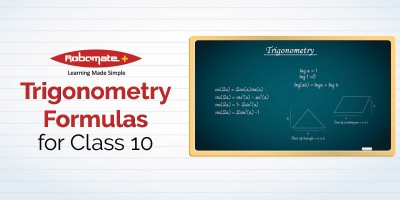State Board Commerce (XI-XII) - Test Papers
Trigonometry Formulas for Class 10
Download Trigonometry Formulas PDF
Introduction:
The word Trigonometry is derived from the Greek word trigōnon means “triangle” and metron means “measure. It is a branch of mathematics which deals with the relationship between lengths, height and angles of triangle. The subject was introduced in 3rd century BC while applying geometry formulas to the astronomical studies. Trigonometry finds applications in number of fields such as
- Engineering
- Astronomy
- Physics and
- Architectural design
Trigonometry formulas are for class 10 has important topics of Linear Algebra, Calculus and Statistics. Inorder to master over the topics, the students are required to understand and learn all the formulas and correctly apply the formulas to solve the subjects.
Click here to Download Trigonometry Formulas
Trigonometric Ratios:
It provides the relationship between the angles and length of the side (adjacent, opposite and hypotenuse) of the right angle triangle.

The Sides:
The different sides of the triangle are referred to as opposite, adjacent, and hypotenuse as shown in the figure
Adjacent side is always next to the angle
Opposite as the name says it is opposite to the angle
Inorder to learn trigonometric ratios, students should understand the following terms of a rectangle
Sinθ= length of opposite side/ length of hypotenuse
Cosθ= length of adjacent side/ length of hypotenuse
Tanθ= length of opposite side/ length of adjacent side
cscθ = length of hypotenuse/ length of opposite side
secθ= length of hypotenuse side/ length of adjacent side
cotθ = length of adjacent side/ length of opposite side
Trigonometric Identities:
Trigonometric Identities refer to all types of angles not just right angle triangle.

Law of Sines
![]()
It can also be re-arranged to:
![]()
Law of Cosines
![]()
It can also be re-arranged to:
![]()
Law of Tangents

Trigonometric Ratios of Complementary Angles:
Any two angles whose sum is equal to 90°
Thus, two angles X and Y are complementary if,
∠X + ∠Y = 90°
∠X is known as the complement of ∠Y and vice-versa.
Ina right angled triangle, the remaining two angles are always complementary.
Make list of Trigonometry formulas or you can also make Trigonometry formulas pdf and store in the mobile or in the desktop to learn.
Best Time to Study: Day or Night?
When is the best time to Study?
When is the best time to study for your brain? It’s one of those extensive discussions among all students; is it better to learn during the night when it is quiet or in the day when there is a lot of activity? Each side has its particular faithful supporters who will boast of the advantages of their favored strategy to attempt and persuade you regarding the best time to study.

Is Day the Best Time to study?
After a decent evenings rest, you’ll likely have more vitality and a higher capacity to focus on studies the following day. A majority of people are reachable during the day, so it’s less demanding to speak with your companions or instructors in the day if you have any inquiries. Normal light is better for your eyes. Fluorescent light in not good for the eyes and can influence our body’s regular routine for rest. We are usually programmed to work during the day and rest during the evening, so we take the day as the best time to study then there are verifiable advantages, for example, having the capacity to go to the library or bookshop.
Is Night the Best Time to Study?
People are more dynamic, louder and serious during the daytime. During the evening it’s calm and quiet. It’s just you and the night owls. So you can study in peacefully. During the evening there are fewer diversions than amid the day. Parents and siblings are sleeping at this time and there will be minimum distractions due to them. In case you’re fortunate to live close to a library that stays open late you can visit such a place where most probably there will be minimum number of users. These arguments demonstrate that for some people night is the best time to study. The night calm and peace of night can help you be more creative and get more ideas than during the day.
Conclusion
Everyone supposes they know what the best time to study is, while in reality, every individual is unique and can choose according to his or her comfort. There are a few people who get more out of learning around night time while others find day as the best time to study.
The Scope and Excitement of Physics
Scope of Physics:
Physics is a part of day-to-day life of an individual. It deals with the study of finite and infinite size objects. The subject is vast and deals with the quantitative and qualitative experimental conditions. Classical physics has following branches.
- Classical Mechanics
- Thermodynamics
- Electromagnetism
- Optics
Modern day Physics deals with concepts of Relativity and Quantum Mechanics.
The Scope and Excitement of Physics pdf
Relativity:
Relativity was studied and introduced by Albert Einstein. The theory of relativity has given insights on the physics of world and atmosphere. This theory helps in understanding the inertial (non-accelerated) and non-inertial (accelerated) frames of reference and subatomic particles. For this theory, Sir Albert Einstein is known as Father of Modern Physics.
The Scope and Excitement of Physics pdf
Quantum Mechanics:
The renowned physicist Richard Feynman has studied and introduced Quantum Mechanics. It deals with the study of motion and interaction of subatomic particles and wave-particle duality. The quantum mechanics give proper mathematical description. It helps in understanding universe operates at the atomic level.
Based on the speed and size of matter in consideration, the domains can be classified as classical mechanics, classical mechanics, relativistic mechanics, quantum mechanics and quantum field theory.
The Scope and Excitement of Physics pdf
Excitement of Physics:
Have you ever imagined the possibility of teleportation? Ever wondered how the teleportation works? Ancient people believed the existence of a device which can define the position of the planet or constellation within no time. The teleportation can help in defining sky maps. Curiosity is the mother of inventions, as your curiosity increases you explore and go into the depth of the subject to understand the topic. Quantum teleportation has been established; the information about atom or photon transported from one place to the other has been established. It is only about matter of things which are being transported not any living creatures like humans
The Scope and Excitement of Physics pdf
Physics Definition, What Is Physics
Constellations and Constellation of Stars
There are thousands and thousands of stars in the night sky and can be observed in the moonless night. These stars can be connected as dots and make different shapes and patterns. The bright stars are easy to identify and can form patterns, such a group of stars is called as constellations. These patterns typically represent animals, mythological people or gods, mythological creatures, or manufactured devices. There are about 88 modern constellations in the celestial sphere. In olden days, these constellation are named after their appearance. The constellations Perseus, Andromeda, Cetus, Cassiopeia and Pegasus are named as per Greek mythology. The name of these constellations varies depending upon the culture e.g.: Pisces – the fish in Greek and Meena- the fish in Sanskrit. The earth rotates in the direction from west to east and hence the constellations also appear to move. Earth is spherical in shape and the entire constellation is not in line of sight, as a result all the constellations are not visible. Northern hemisphere constellation cannot be viewed in south and southern hemisphere constellation cannot be viewed in north. A person at the equator can see most of the constellations.
The Scope and Excitement of Physics pdf
Zodiac constellations:
The word zodiac refers to the area of the sky approximately 8° north or south of the sun’s path along the sky (called the ecliptic). The path of the moon and visible planets are part of the zodiac belt. There are 12 major constellations in ecliptic and were used to track time based on movement of sun. The major constellations are
Aries (Mesha), Taurus (Vrushabha), Gemini (Mithuna), Crab/Cancer (Karka), Leo (Simha), Virgo (Kanya), Libra (Tula), Scorpion (Vruschika), Saggitarius (Dhanusha), Capricorn (Makara), Aquarius (Kumbha), Pisces (Meena).
Big Dipper:
Saptarishi or big dipper is a group of seven stars which can be witnessed in the northern hemisphere. It is a part of Ursa Major (The great Bear). This group of stars looks like big ladle or like a wheel. Ursa Major constellation has two stars which point towards the pole star.
Pole star commonly called as Polaris or Dhruva, is the only star in the night which is constant in position and does not move from east to west. The position looks stationery as it is above the earth’s axis.
Orion:
It is a constellation seen throughout the world. Orion is also called as ‘the hunter’ or Mriga in India. This constellation has a number of bright large stars. A section of the constellation has three large stars which are in line with each other and forms the “belt” of the hunter. These stars point towards the brightest star in the night sky – Sirius. The constellation can be viewed at night in the sky. Zodiac constellations are interesting to identify and watch with the help of a star chart. Try yourself to identify the constellations!








